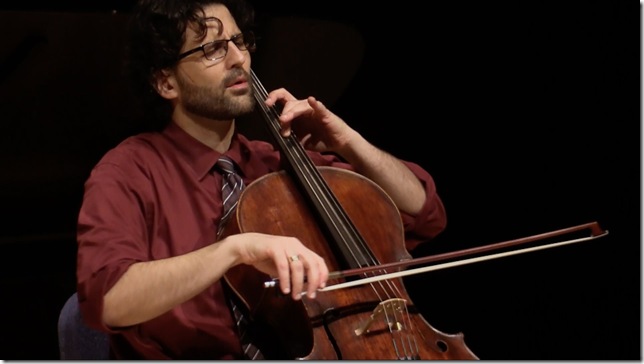I have loved the sound of the cello since I heard a broadcast of Pablo Casals playing from the festival he founded in Puerto Rico.
Subsequently I heard Sir John Barbirolli practicing the cello through an open window: we were neighbors in Manchester, England. At London’s Royal Festival Hall I was close enough to see every gesture of Jacqueline Du Pré, the day she rocketed to fame playing in the Elgar Cello Concerto, with Barbirolli conducting the Hallé Orchestra.
And most memorably, the surprise dessert at an outdoor summer lunch party in Lenox, Mass., when Yo-Yo Ma played an unaccompanied Bach partita on his cello for a generous donor to the arts. It was a sublime experience on a sunny day.
Joining these cello highlights must surely go the artistry of Amit Peled, who on Dec. 7 at the Society of the Four Arts in Palm Beach gave an exceptional tribute to the art of Casals joined by 18 string-playing members of the Palm Beach Symphony under their director, Ramón Tebar. Peled, an Israeli-American cellist, played Casals’s own cello, a 1733 Matteo Gofriller loaned to him by the great cellist’s widow, Marta.
It was a night to remember. The careful placement of the players produced an all-round caliber of balanced sound, both delicate and pleasing, refined and artistic. Twice this normally taciturn audience rose to their feet, roaring applause, so high was the quality of the music-making.
The music opened with a Cello Sonata by George Frideric Handel, the No. 1 in G minor, written in Hamburg in 1704 when Handel was just 19; the contemporary Croatian cellist Marko Miletić converted the sonata into a concerto. It opens with a bright, bright melody in the strings picked up by the solo cellist, who brought out the beautiful sound of his instrument. The fast second movement is jig-like and has beautiful accompanying string work as the cello saws away with sweet refinement.
The solo cello opens the third movement in a slow larghetto theme of unusual beauty. Cheeky, tripping violins open the last movement with a tune that is recognizable to all; hints of Handel’s Water Music appear, which of course came much later when he lived in England. Polite applause greeted Handel’s prentice work.
Max Bruch’s Kol Nidrei (Op. 47), arranged for solo cello and strings by Volkmar Fritsche, draws from Jewish folk melodies, just as Bruch freely drew from Scottish folk songs in his Scottish Fantasy and other folk tunes in his violin concertos. A quiet introduction by the violins led to warm heartfelt playing from Peled as the orchestra echoed certain of his phrases. The strings got a new melody, which the soloist picks up and develops into charming variations. Drawing to a close, the soloist goes from low to high and back to low again, but a rising scale seems to want to settle into an Elgarian ending, rich in tone. No one dared to break the silence with applause, wanting to keep the beauty of this moment remaining in the collective mind.
Third came a very fast Tarantella by the Czech cellist and composer David Popper. Lots of plucked strings surround a cheerful central melody. Peled was able to show the range of his skills with some quiet passages, contrasting them immediately with double forte. The dance gets faster and faster, and remarkable double-octave work from the soloist brought about the first standing ovation and roar of approval.
Peled then addressed the audiences telling them that the first three pieces
were identical to Casals’s first appearance in the United States in 1915. Closing the first half of the program, Peled stayed with Casals, this time choosing to play Song of the Birds, the cellist’s own arrangement of a Catalan folk melody with which Casals began all his concerts to repudiate Spain’s government after its wrenching civil war.
Tebar then told the audience that it was Ray Robinson — the symphony’s conductor emeritus, who died in October at 82 — who introduced him to Amit Peled in 2008. Back then they played the next piece together, Haydn’s Cello Concerto No. 1, bringing things full circle.
The sweet strings opened with Haydn’s familiar music which the soloist picks up and develops. Peled played with earnestness and solid artistry in attacking each difficult phrase. A small cadenza didn’t do him justice. A slow reflective melody opens the second movement. Abundant key changes were effected seamlessly as a continuously lovely haunting tune sent Peled into closed-eye reveries, letting the music emanate from the body, face turned upward and away from the cello in ecstacy. A gentle ending ensues.
The third movement has an exciting start, well-played by the selected string players. Clever solo work from the artist follows — these were the “fireworks” the audience was waiting for, and they were not disappointed by Peled’s excellent mastery. And what a reception he got: Roars of approval, a standing ovation and loud sounds of applause for three solo bows, unheard-of at these concerts.
Ending the program was Ernest Bloch’s Prayer, composed when he was director of the Cleveland Institute of Music in 1924. It is a three-part suite, originally for cello and piano. The first movement evokes the ornate mournful tropes of Hebrew prayers as chanted by the Eastern European Ashkenazis. Beginning in the middle range, a fine quartet develops in which the accompanying orchestral strings actually sound like singing voices. Interrupted by the solo cello in a lyrical strain of yearning for calmer times — peace perhaps — it ends on a drawn-out beautiful note from the soloist.
